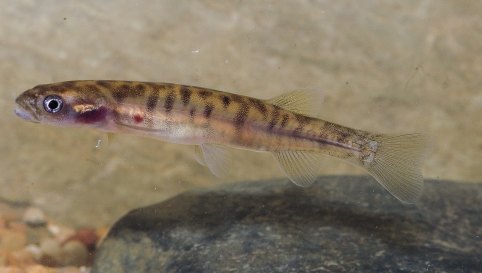
“This includes establishing captive breeding programs, trout-free refuges, translocations, and the eradication of feral and invasive species,” she said.
The Invasive Species Council last year calculated the number of plants and animals lost to extinctions since 1960 at 23 animals and four plants.
After the devastating Black Summer bushfires, researchers captured seven Yalmy galaxias in the connected tributaries of the lower Snowy River in East Gippsland, in an attempt to breed them in captivity. Six injured juvenile fish died, and one was later returned to its habitat.

Scientists are unsure whether the Yalmy galaxias has been rendered extinct or is clinging to life.Credit: Tarmo A. Raadik
Between 2020 and 2023, twice-yearly surveys failed to find any surviving Yalmy galaxias, before researchers discovered 20 in March last year. They were listed as critically endangered that month.
The Invasive Species Council’s director of advocacy, Jack Gough, said government efforts had clearly not been enough to save the galaxias.
Loading
“They need a specific rescue mission for the Yalmy and more trout-free havens across all the habitats of the 14 other critically endangered galaxias. Anything less is guaranteeing the minister’s no new extinction promise is broken.”
Environment groups are urging the Australian, Victorian and NSW governments to act immediately on other critically endangered galaxiids, which are Australia’s most threatened group of animals.
Dr Carol Booth, from the Invasive Species Council, said 15 species had recently been assessed by fish experts as being more than 50 per cent likely to become extinct by 2040, due to sediment run-off and invasive trout.
“Because galaxiids didn’t evolve with introduced trout species, they do not recognise them as predators and cannot coexist,” she said.
“Some survive only above waterfalls that trout cannot scale – but they could easily be lost if an unthinking fisher transferred trout to a galaxias refuge.”
There are 22 galaxias species in Australia and brown trout, an introduced species, are a key threat to all of them.
The federal environment department said trout have formed a self-sustaining population in the Yalmy River, the critically endangered species’ home, and that “no individuals [galaxias] have been found where salmonids are present”.
It noted the galaxias species “may lack an effective anti-predator response” to trout. When galaxias smells its native predator – the southern shortfin eel – nearby, it tries to hide. But this instinct does not kick in when trout are nearby.
The groups, including the Biodiversity Council, Invasive Species Council, Australian Conservation Foundation and Environment Victoria, are calling for governments to circumvent the typically bureaucratic and slow process that comes with endangered species rescue missions.
An action plan must be released now, they said, backed by funding to rescue Yalmy galaxias before they die in the wild.
The groups have urged the creation of trout-free havens in rivers, and for galaxias to be restocked from captive breeding programs. They also want the development of a long-term action plan to create sustainable protections from trout, including the prevention of stocking trout for anglers in rivers where galaxias live.
Plibersek announced last week she would bring to parliament a bill to create a national environment protection agency to assess development proposals. She has also vowed to reform national environment laws under her “nature positive plan”, but the deadline has not yet been set.
Get to the heart of what’s happening with climate change and the environment. Our fortnightly Environment newsletter brings you the news, the issues and the solutions. Sign up here.



























